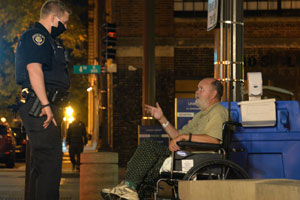Safety and Security
Safe and secure for all users
Objectives
- Reduce fatal and serious injury crashes and improve safety and security for all modes of passenger travel and freight transport.
- Reduce the transportation system’s vulnerability to natural- and human-caused incidents and threats, including climate change and terrorism.
Strategies summarized
- Safety and security are at the heart of providing a comfortable, trustworthy system and will be a focus in all areas of transportation investments.
- Safety and security include identifying and addressing existing safety and security concerns and building a transportation system that avoids future problems.
Increasing the safety and security of people who use the region’s transportation system is paramount across all agencies that plan and operate the system. To do that requires an understanding of what areas are vulnerable and why. Using data and analysis to identify these areas helps the region focus on the greatest risks and proactively avoid creating new vulnerabilities.

Toward Zero Deaths
The region has work to do to reach the vision of a transportation system that is safe for all users. The Met Council joins its partners, including MnDOT, the Minnesota Department of Public Safety, the Minnesota Department of Health, and local governments, to advance Toward Zero Deaths, where traffic fatalities and serious injuries are no longer acceptable.
Walking and biking
The region uses best practices to provide and improve safe walking and bicycling, since people who walk or bike are the most vulnerable transportation system users. However, an increasing number of pedestrians who are killed or seriously injured in traffic crashes are making up larger percentage of overall deaths and serious injuries.
Transit
Safety and security on transit is, in part, as much about the perception of safety. That means providing environments that feel safer through lighting, design, and technology like cameras. Transit providers have installed cameras onboard buses and trains, and in some stations. When incidents do happen, Metro Transit police work with local enforcement agencies to respond quickly and effectively.
Equity
Not everyone experiences the region’s transportation system the same. For example, data show that people of color experience more frequent stops and enforcement on transit. The region is responsible for making sure that transportation system enforcement does not create or continue racial inequities. In 2020 and 2021, Metro Transit has been working with community partners to focus on equity in its policies, practices, and procedures.
Freight
Freight rail incidents tend to be high profile and have the potential to cause deaths, injuries, and damage. The Federal Railroad Administration has a National Rail Safety Action Plan that identifies safety improvements for railroad companies. The region should also be planning to raise the numbers of safe rail corridor crossings for people and vehicles.
Climate
The changing climate poses new threats to transportation infrastructure, particularly from warming winters, extreme rainfall, and heat waves. The Met Council developed a Climate Vulnerability Assessment to identify risks to that infrastructure.
Measuring performance
Performance measures used to measure improved safety and security include:
- Number and rate of crashes with serious or fatal injuries
- Fatal or incapacitating injuries involving bicyclists or pedestrians